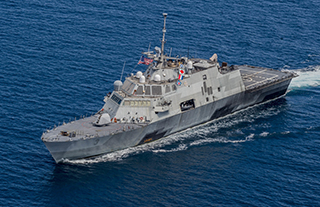(Bloomberg) — Confronted with concerns that its lightweight littoral combat ship may not survive combat, the U.S. Navy promised a better-armed version that’s more like a frigate. It would still fall short, congressional auditors say.
“While the Navy’s proposed frigate will offer some improvements over LCS, it will not result in significant improvements in survivability” because it “will still be based on a hybrid of commercial and Navy shipbuilding specifications,” the Government Accountability Office said in a draft report obtained by Bloomberg News.
In the report labeled “For Official Use Only,” the GAO recommended that Congress consider not funding any littoral combat ships for fiscal 2017 “because of unresolved concerns with lethality and survivability, the Navy’s lack of requested funding to make needed improvements and the current schedule performance of the shipyards” where Lockheed Martin Corp. and Austal Ltd. build different versions of the vessel.
Adding a Ship
But congressional support for the ship, and the shipbuilding jobs it provides, remains strong. While the Pentagon requested funding for two ships in the fiscal year that begins Oct. 1, the House Armed Services Committee added a third in H.R. 4909, the defense policy bill that’s being debated on the House floor this week. The House Appropriations did the same in the defense spending measure it approved Tuesday.
Captain Thurraya Kent, a Navy spokeswoman, said in a statement that she wouldn’t comment on the GAO’s draft report because she didn’t “know what changes may or may not be made” in the final version and because the Navy’s views will be incorporated in a Pentagon response.
Critics have long questioned whether the LCS, built for operations such as mine-clearing and submarine-hunting in shallow coastal waters, would be able to survive in combat.
‘Considerable Reservations’
In 2014, Defense Secretary Chuck Hagel, expressing “considerable reservations,” cut the planned fleet to 32 of the original ships, followed by the purchase of 20 better-armed frigates. This year, Hagel’s successor, Ash Carter, cut the total to 40, with as many as 12 of them frigates.
The LCS program has been plagued by problems, leading the Navy to cite Lockheed for quality control issues earlier this month.
The Navy plans a competition between Bethesda, Maryland-based Lockheed and Henderson, Australia-based Austal to choose one design for the “small surface combatant” as soon as 2018, according to the GAO.
Planned improvements include an improved missile decoy system, reducing the vessel’s magnetic signature to mines, added armor, “shock hardening” to lessen the risk of munitions magazine detonations and a longer-distance “over-the-horizon” missile. The new vessels are estimated to cost $8 billion, in what’s now a $29 billion program.
‘It’s Affordable’
“We felt very good that we’ve given the fleet what they needed and what” regional combat commanders requested, then-Chief of Naval Operations Admiral Jonathan Greenert told reporters when the plan was released in late 2014. “We believe it’s affordable. That was a critical tenet.”
But the GAO said the planned improvements recommended by a Navy task force put a priority on keeping expenses down and getting the ships into production as soon as possible “over higher levels of combat capability,” the GAO said.
Nor will they “fully address” all of Hagel’s concerns, such as “reducing the vulnerability of the ship to sustaining damage as compared to the current LCS,” it said.
The agency also said the Navy’s cost estimate “may overstate its affordability” compared with other options. The service plans to award a contract “before establishing a sound business base that sets forth realistic technical, cost and schedule parameters,” it said.
---
By Bloomberg News - Tony Capaccio





